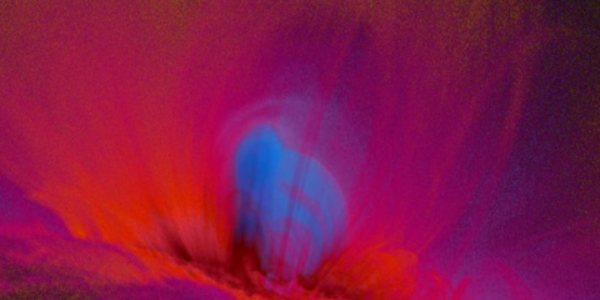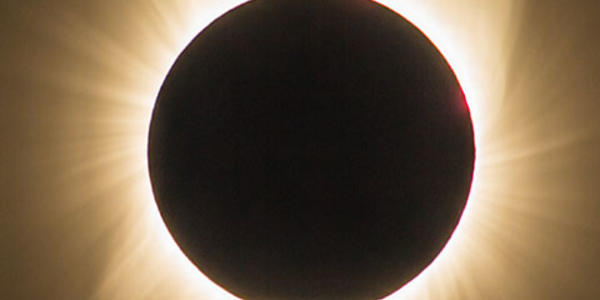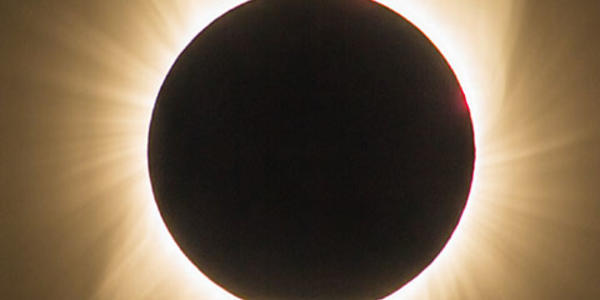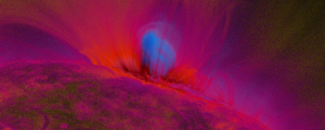
Rain, wind, and storms are everyday features of our weather on Earth. But beyond our atmosphere, scientists are monitoring phenomena in space that are a close cousin to terrestrial weather. The term “space weather” was adopted in the late 20th century to describe the space conditions, and has become a keen area of study for many heliophysicists, meteorologists, and skywatchers.
Understanding space weather means looking beyond our experiences on the Earth’s surface. Rather than wind, rain, thunder, and seasonal changes, space weather is defined by the geospace and interplanetary conditions (like plasmas temperatures, particle densities, solar wind speeds, and magnetic field orientations) and produce outcomes unlike terrestrial weather.
Causes of Space Weather
It all starts at the Sun—our dynamic star that’s under continuous change, following its solar activity cycle.
As the Sun changes, so does the space around it, called the heliosphere. As the solar cycle evolves, changes in the Sun's magnetic field store vast amounts of energy. Often this energy dissipates gradually, heating the Sun's atmosphere or being swept away by solar wind. Sometimes a fraction of it is released impulsively, triggering powerful events that can lead to severe space weather near Earth.
During years of high activity, called solar maximum, events like solar flares and eruptions occur more often and release enormous amounts of extra energy over the course of just a few minutes—much more energy than what Earth has produced in all of human history! These events are so powerful they can be felt across the solar system, from the Sun's surface to tens of millions of miles away on Earth and beyond.
NOAA’s satellites, sensors, and imaging technology record those events for researchers at NOAA’s National Centers for Environmental Information and NOAA’s Space Weather Prediction Center (SWPC) to monitor and study the Sun and space weather.
SWPC analyzes the real-time data each day to predict changes in space weather, issuing alerts and warnings when necessary and classifying the events into NOAA Space Weather Scales.
Solar Eruptions: Flares and Coronal Mass Ejections
Solar eruptions are massive energy releases from the solar atmosphere that send huge amounts of radiation and mass streaming into space. These eruptions manifest in many ways. One way is solar flares—they are short, impulsive bursts of electromagnetic radiation in different frequencies. They can blast x-rays (and also energetic particles) into the interplanetary space. Weak flares are common occurrences on the Sun, while intense flares are the most energetic events in the solar system and occur a few times per solar cycle.
Another manifestation of solar eruptions, called coronal mass ejections (CMEs), are powerful outbursts of magnetic field and plasma from the Sun's corona. CMEs fly into space reaching the outer edges of the solar system. Billions of tons of plasma from the Sun’s corona fire off like a blast into space traveling between 600 to 900 km/s. The most powerful CMEs can reach speeds of a few thousand km/s.
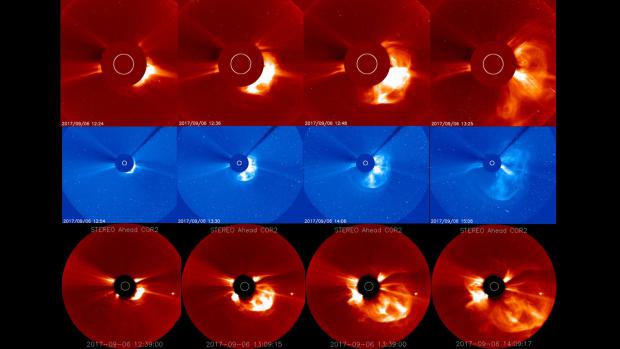
Coronal Holes
Coronal holes are dark regions in the Sun’s atmosphere detected by ultraviolet and x-ray imaging. They are the source of high-speed solar wind streams. The winds generated by a coronal hole pass virtually unhampered into space. Sometimes present for many months, the holes rotate as the Sun rotates every month. These high-speed streams collide with the slow solar wind that is generated outside the holes. The visual effect resembles the spiral of a rotating sprinkler, which scientists call the Parker Spiral. This collision can lead to the formation of shockwaves in the solar wind and can produce disturbances to Earth’s magnetosphere, the protective magnetic field that surrounds the planet for thousands of miles above the surface.
Geomagnetic Storms
Flares, CMEs, and high speed streams cause space weather-induced storms near Earth referred to as geomagnetic storms. These near-Earth responses to events from the Sun demonstrate the far-reaching impact of the star’s tremendous power. The Sun’s eruptions, precursors to storms, become problematic once they interact with the Earth’s magnetosphere and ionosphere. Solar storms can temporarily disrupt systems on Earth, from radar to airline navigational tools.
GPS signals are also susceptible to space weather events, which can disturb the ionosphere and change a GPS receiver’s ability to calculate an accurate position from a satellite signal. With more than 2,000 satellites in space and GPS features common in cell phones and vehicles, the implications can be broad if signals are hampered. At home, our telecommunications systems, radio waves, cellular service, and power grids can all be affected by space weather.
In March 1989, millions of people lost power when a geomagnetic storm caused a power grid failure in Quebec and even melted some power transformers in New Jersey. During another incident around Halloween 2003, a geomagnetic storm forced airline rerouting, halted spacecraft instrumentation, and caused power failure in Sweden.
The Northern and Southern Lights come about from particles reacting to the everyday atmospheric matter in Earth’s protective buffer.
The Human Experience
Space weather can reach Earth’s immediate vicinity within a few minutes from the solar event that caused it. Observations from key satellites, including GOES and DSCOVR, help scientists better understand those phenomena and detect potential harm to our technologies. In October 2016, a U.S. presidential executive order required the development of a nationwide strategy to cope with security and disaster issues related to space weather.
Not all outcomes of space weather are negative. Aurorae claim the distinction of being a natural, beautiful consequence of space weather. Aurorae could be considered space weather’s equivalent to the rainbow, except that the shimmering curtains of light have nothing to do with refraction of sunlight by rain droplets. They develop from the collision of charged particles from solar eruptions with Earth’s upper atmosphere. The same space weather event of Halloween 2003 also created a remarkable aurora. That aurora borealis, also known as the Northern Lights, was observed in many regions, even in low latitudes.
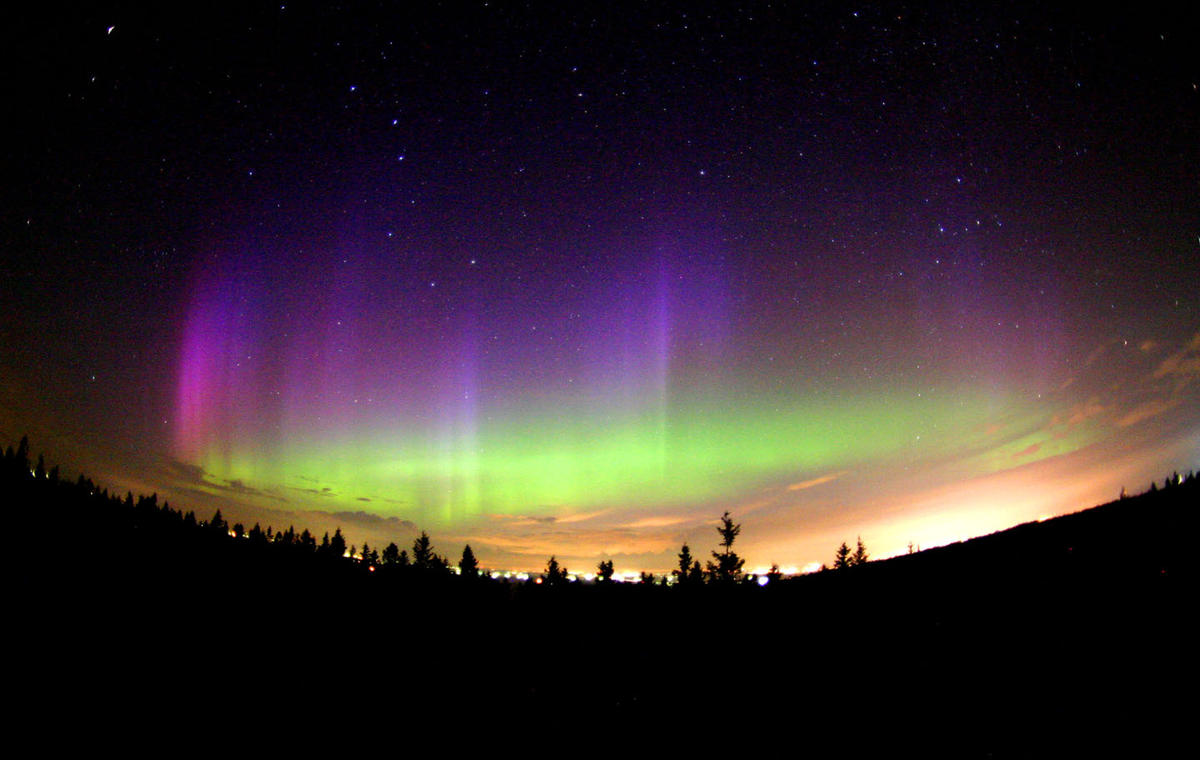
Space Weather Data
NCEI archives and scientifically stewards a broad assortment of space weather data for public use. Solar and space environmental data archives include extensive collections from solar observatories, ground ionospheric sounders, and satellites. The datasets include solar radio flux, sunspot numbers, solar imagery, and geomagnetic indices. They are used to produce forecasts, such as the monthly sunspot number forecast. Most notably, sunspot numbers represent one of the longest continuous climate records available. The data give scientists the means to make forecasts and issue space weather advisories and alerts.

